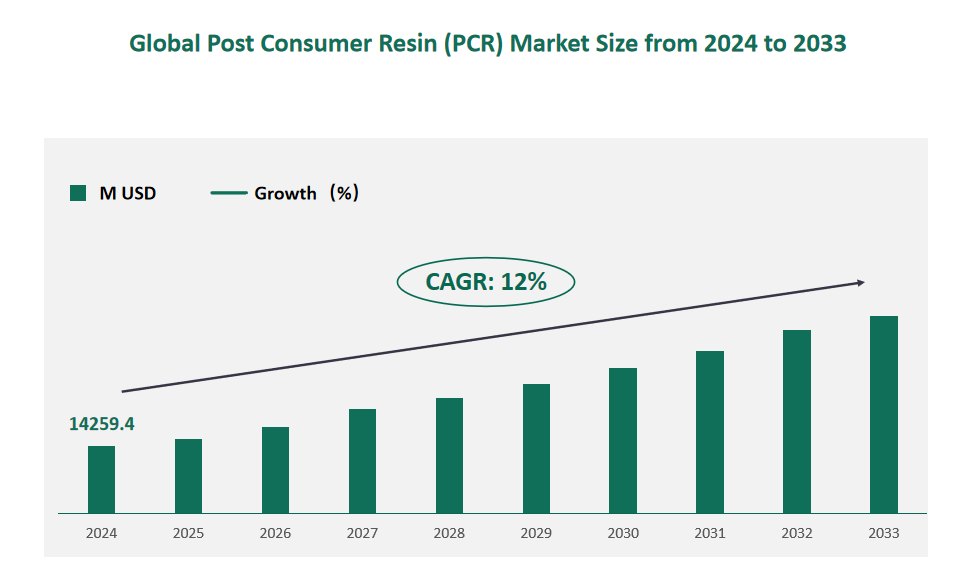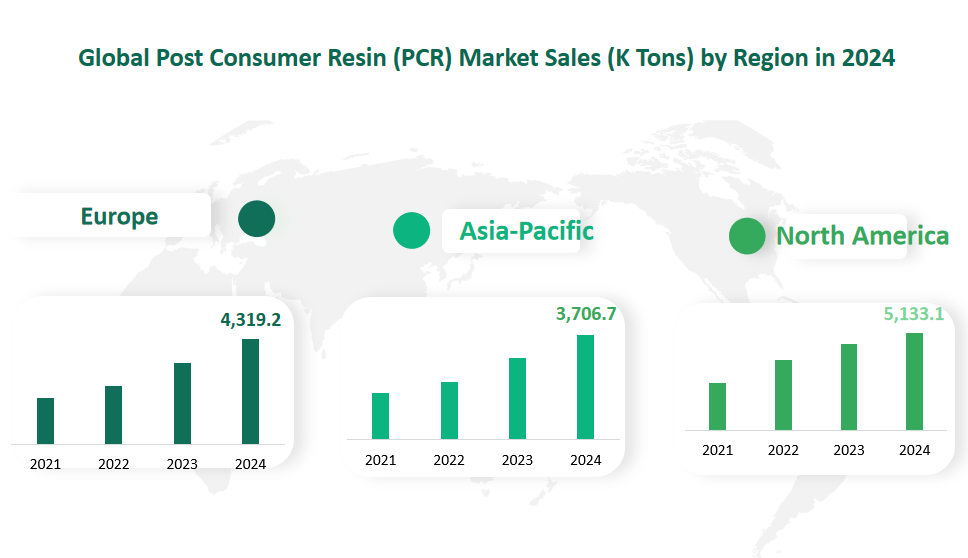1 Global Post Consumer Resin (PCR) Market Size (Value) and CAGR (2024-2033)
In 2024, the global Post Consumer Resin (PCR) market was valued at USD 14259.4 million, with a CAGR of 12% from 2024 to 2033.
PCR (Post Consumer Resin) is the technical term for plastic that has already been recycled and is ready to use again. It begins with the collection and sorting of recycled products – plastic bottles for example. These bottles are then separated from the other plastics, washed and cleaned of all other materials (for example the labels, bottle tops etc). The recycled plastic is then extruded and reprocessed into PCR.
Figure Global Post Consumer Resin (PCR) Market Size (M USD) and CAGR 2024-2033

2 Post Consumer Resin (PCR) Market Drivers
The Post Consumer Resin (PCR) market has experienced significant growth in recent years, driven by a combination of environmental, economic, and regulatory factors. One of the primary drivers is the increasing global focus on environmental sustainability. Governments and regulatory bodies worldwide are implementing policies to reduce plastic waste and promote recycling. For instance, the European Union has set ambitious targets for recycling plastics, and many countries have introduced laws to mandate the use of recycled materials in packaging and other applications. These policies create a favorable environment for the growth of the PCR market.
Consumer behavior is another significant driver. There is a growing awareness among consumers about the environmental impact of plastic waste, leading to a preference for products made from recycled materials. This shift in consumer demand encourages manufacturers to incorporate PCR into their products, thereby increasing the market demand for PCR. Additionally, companies are recognizing the value of PCR in enhancing their corporate social responsibility (CSR) initiatives, which can improve brand image and customer loyalty.
Economic factors also play a crucial role in the growth of the PCR market. The cost of virgin plastics is influenced by fluctuating oil prices, making PCR a more stable and cost-effective alternative in the long run.
3 Post Consumer Resin (PCR) Market Restraints
Despite the positive outlook, the PCR market faces several challenges and restraints that could hinder its growth. One of the primary challenges is the quality and consistency of recycled materials. PCR may not always meet the same quality standards as virgin plastics, which can limit its use in certain high-performance applications. This quality gap can be attributed to the complexity of recycling processes and the variability in the composition of recycled materials.
Another significant restraint is the lack of standardized recycling processes and infrastructure. The efficiency and effectiveness of recycling facilities vary widely, which can impact the quality and availability of PCR. Additionally, the collection and sorting of post-consumer plastics require robust infrastructure and logistical support, which may not be available in all regions. This can lead to inefficiencies and higher costs in the recycling process.
4 Global Post Consumer Resin (PCR) Market Sales and Share by Type in 2024
PET, or Polyethylene Terephthalate, is a clear, strong, and lightweight plastic that is widely used for packaging foods and beverages, especially in convenience-sized soft drinks, juices, and water. PET is completely recyclable and is the most recycled plastic globally. Its excellent barrier properties make it ideal for food and beverage containers, contributing to its significant market share. In 2024, PET is expected to dominate the PCR market with sales reaching 5,073.5 K Tons, driven by its extensive use in the packaging industry and the growing demand for sustainable materials.
Polypropylene (PP) is a thermoplastic polymer known for its versatility and strength. It is used in a variety of applications, including packaging for consumer products, automotive parts, textiles, and more. PP is highly recyclable and is increasingly being used in applications where sustainability is a key consideration. In 2024, PP is projected to have sales of 2,047.7 K Tons, reflecting its growing importance in the PCR market.
High-Density Polyethylene (HDPE) is a versatile plastic material used in a wide range of applications, including plastic bottles, milk jugs, shampoo bottles, and piping. HDPE is known for its high strength-to-density ratio, outstanding tensile strength, and resistance to impact. It is highly recyclable and is often used in food and beverage containers due to its safety and durability. In 2024, HDPE is expected to have sales of 3,683.2 K Tons, driven by its widespread use in packaging and the increasing focus on recycling and sustainability.
Low-Density Polyethylene (LDPE) is a soft, flexible, and lightweight plastic material. It is known for its low-temperature flexibility, toughness, and corrosion resistance. LDPE is commonly used in applications such as plastic bags, films, and flexible packaging. While it is not as strong as HDPE, its flexibility makes it suitable for applications where flexibility is required. In 2024, LDPE is projected to have sales of 1,279.1 K Tons, reflecting its growing demand in the flexible packaging sector.
Table Global Post Consumer Resin (PCR) Market Sales and Share by Type in 2024
Type | Market Sales (K Tons) 2024 | Market Share 2024 |
PET | 5073.5 | 35.58% |
PP | 2047.7 | 14.36% |
HDPE | 3683.2 | 25.83% |
LDPE | 1279.1 | 8.97% |
Others | 2176.0 | 15.26% |
5 Global Post Consumer Resin (PCR) Market Sales and Share by Application in 2024
Packaging and Consumer Goods is the largest application segment, expected to reach 5,638.3 K Tons in 2024. This segment includes a wide range of products such as bottles, containers, and packaging materials. The use of PCR in this sector is driven by the increasing demand for sustainable packaging solutions and regulatory mandates to reduce plastic waste. Companies are increasingly incorporating PCR into their packaging to meet consumer expectations for environmentally friendly products.
Construction is another significant application area, with projected sales of 4,115.4 K Tons in 2024. PCR is used in various construction materials, including pipes, fittings, and insulation. The use of recycled plastics in construction not only reduces waste but also offers cost-effective and durable solutions. The growing focus on sustainable building practices is driving the demand for PCR in this sector.
Textile Fiber or Clothing is an emerging application area, with sales projected to reach 2,145.9 K Tons in 2024. PCR is increasingly being used in the production of fibers and textiles, offering a sustainable alternative to virgin materials. This segment is driven by the growing consumer demand for eco-friendly clothing and the need to reduce the environmental impact of the fashion industry.
Landscaping or Street Furniture is a niche but growing application, with sales expected to reach 915.3 K Tons in 2024. PCR is used in the production of outdoor furniture, decking, and landscaping materials. The durability and weather resistance of PCR make it an ideal material for these applications, while its recycled nature aligns with sustainability goals.
Table Global Post Consumer Resin (PCR) Market Sales and Share by Application in 2024
Application | Market Sales (K Tons) 2024 | Market Share 2024 |
Packaging and Consumer Goods | 5638.3 | 39.54% |
Construction | 4115.4 | 28.86% |
Textile Fiber or Clothing | 2145.9 | 15.05% |
Landscaping or Street Furniture | 915.3 | 6.42% |
Other Uses | 1444.5 | 10.13% |
6 Global Post Consumer Resin (PCR) Market Sales by Region in 2024
North America is a leading region in the PCR market, driven by strong environmental policies and consumer demand for sustainable products. The United States and Canada are key markets, with significant investments in recycling infrastructure and technology. The region is expected to maintain its dominance, with sales reaching 5,133.1 K Tons in 2024.
Europe is another major region, with sales projected to reach 4,319.2 K Tons in 2024. European countries have been at the forefront of environmental sustainability, with stringent regulations on plastic waste and high recycling rates. The growing demand for PCR in packaging and construction is driving the market in this region.
The Asia-Pacific region is experiencing rapid growth, with sales expected to reach 3,706.7 K Tons in 2024. China, Japan, and South Korea are key markets, driven by increasing awareness of environmental issues and the growing demand for sustainable materials. The region’s large manufacturing base and expanding middle class are also contributing to the growth of the PCR market.
Figure Global Post Consumer Resin (PCR) Market Size by Region in 2024

7 Major Players in Global Post Consumer Resin (PCR) Market
7.1 KW Plastics
KW Plastics is the world’s largest plastics recycler for HDPE and PP, known for its high-quality post-consumer resins. Established in 1981, the company is headquartered in the USA and operates as an ISO:9001-2015 registered facility with ISO-IEC 17025:2005 accredited labs. KW Plastics produces a wide range of polyethylene and polypropylene resins for various industries, including personal care, automotive, agriculture, construction, and flexible packaging. Their products are renowned for their natural color, high stiffness, and good impact resistance, making them suitable for blow molding, extrusion, and blown film applications.
In the most recent year, KW Plastics reported sales of 286.0 K Tons, with a revenue of 248.63 M USD.
7.2 Indorama Ventures
Indorama Ventures Public Company Limited is a world-class chemical company headquartered in Bangkok, Thailand. Founded in 1994, Indorama Ventures has grown from a small listed company into a leading integrated chemical company with a significant presence in the PCR market. The company operates 124 manufacturing sites across 33 countries, focusing on Integrated Oxides and Derivatives (IOD), Combined PET, and Fibers. Indorama Ventures entered the recycling business in 2011, transforming post-consumer PET bottles into flakes, rPET resins, and recycled polyester yarns.
In the most recent year, Indorama Ventures reported sales of 191.6 K Tons, with a revenue of 179.96 M USD.
7.3 Envision
Envision is a leading recycler of HDPE plastics and supplier of innovative Post Consumer Resin (PCR) solutions. Established in 2001, Envision Plastics is headquartered in Reidsville, North Carolina, with additional facilities in Chino, California. The company is a technology leader in HDPE recycling and the only producer of food-grade high-density polyethylene (HDPE) in North America. Envision Plastics recycles HDPE bottles collected from homes, businesses, and schools, transforming them into high-quality resins for various industries, including food, beverage, personal care, and consumer healthcare.
In the most recent year, Envision reported sales of 125.0 K Tons, with a revenue of 106.73 M USD.

